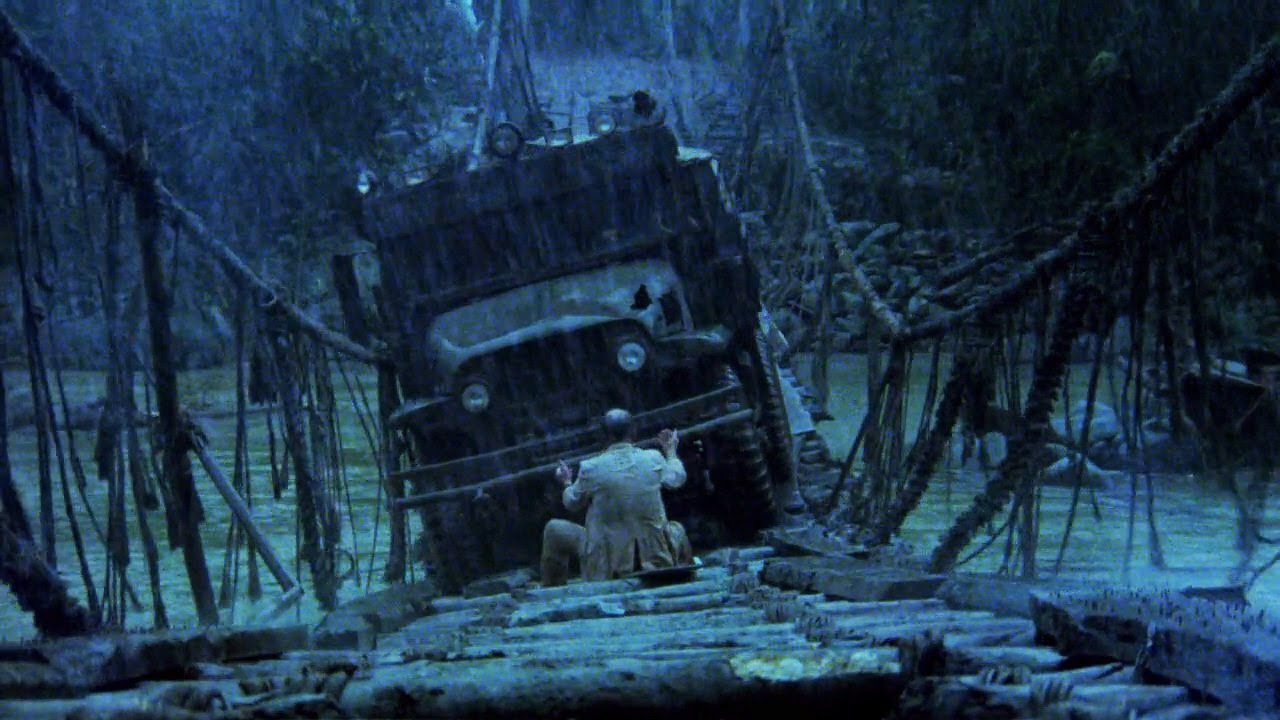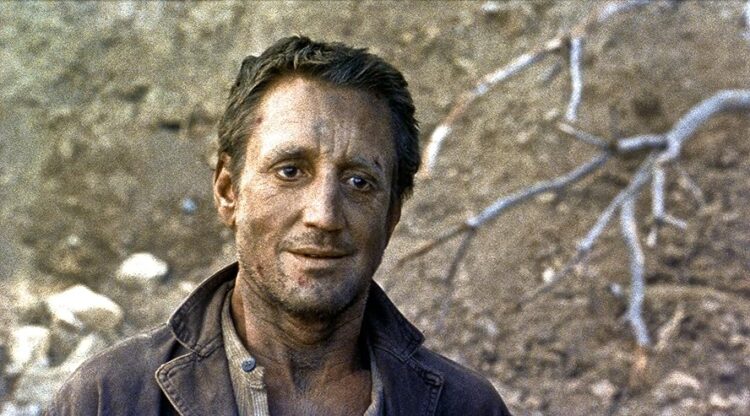I still recall watching this movie when I was a child. I was glued to the television, and though I haven’t seen it since its debut on the tv I remember how good it was. I truly felt for the character Scanlon, played by Actor Roy Scheider. Sorcerer, directed by William Friedkin, is a cinematic masterpiece that blends intense suspense, character-driven storytelling, and jaw-dropping visuals to create a harrowing experience that lingers long after the credits roll. Friedkin passed away yesterday at age 87. He was a talented director, and I’ve watched most of the movies that he made. To Live and Die in L.A. The French Connection and the The Exorcist are three of his best work.
Sorcerer is a remake of the French classic “The Wages of Fear,” which I have never seen. Set in a remote South American jungle, Sorcerer is a fascinating movie; four desperate men from different backgrounds find themselves united by their shared need for redemption. I love the fact that they have this dangerous job of being forced to transport volatile nitroglycerin across treacherous terrain in aging trucks. They’re faced with a life-or-death mission that pushes them to their limits both physically and mentally.
The suspense is palpable as the characters navigate treacherous landscapes, rickety bridges, and unforgiving weather conditions. You can feel the tension in the air as every bump in the road could trigger a catastrophe. One of the film’s standout elements is its meticulous attention to detail, capturing the gritty reality of their journey.
Roy Scheider delivers a remarkable performance as the central character, portraying a man with a dark past and a burning desire to start anew. His portrayal of the complex emotions his character goes through is a testament to his acting prowess. The supporting cast, including Bruno Cremer, Francisco Rabal, and Amidou, also contribute nuanced performances that elevate the film’s emotional depth. I never knew until today that Steve McQueen was the director’s first choice for the main role. He tried to get Clint Eastwood or Jack Nicholson, but neither wanted to travel at that time. Scheider did a good job despite being cast as a last pick.
The film’s visual storytelling is stunning, with Friedkin masterfully using cinematography to convey the characters’ isolation and the hostile environment they’re trapped in. The sound design plays an equally crucial role, immersing the audience in the nerve-wracking experience of transporting highly explosive cargo.
Friedkin’s direction expertly builds tension and suspense, taking the audience on a roller-coaster ride of emotions. The moral dilemmas faced by the characters mirror the viewer’s own conflicting emotions, prompting reflection on the choices we make in life-altering situations.
The film’s title refers to one of the trucks, which has the name Sorcerer painted across the hood (the other is named Lazaro); the narrative features no supernatural or magical character or event. As director William Friedkin went location scouting in Ecuador and researched the peculiar ornaments on cargo trucks he had seen there, he noticed there were names painted on them, which ranged from relatives to mythological references. Firstly he came up with the name Lazaro after Lazarus; then after some time struggling to find another moniker, a listen to the Miles Davis album Sorcerer served as an inspiration to name the other truck, though the word was painted in French: “Sorcier”. Friedkin then decided to change his working title Ballbreaker for Sorcerer, which he described as “an intentional but ill-advised reference to The Exorcist“.
Friedkin thought the title fit the film’s general theme:
The Sorcerer is an evil wizard and in this case the evil wizard is fate. The fact that somebody can walk out of their front door and a hurricane can take them away, an earthquake or something falling through the roof. And the idea that we don’t really have control over our own fates, neither our births nor our deaths, it’s something that has haunted me since I was intelligent enough to contemplate something like it.[38]
Despite its box office struggles upon release, “Sorcerer” has rightfully earned its place as a cult classic and a testament to the power of cinematic storytelling. Its themes of redemption, survival, and human nature are universal, making it a timeless film that continues to captivate audiences. The film received generally negative reviews upon its release. It has grown as a cult film since. It bombed at the box office because it opened the week after Star Wars debut. Friedkin considered Sorcerer among his favorite works, and the most personal and difficult film he ever made
In conclusion, “Sorcerer” is a gripping and visceral cinematic experience that showcases the human spirit’s resilience in the face of unimaginable odds. With its compelling characters, breathtaking visuals, and heart-pounding suspense, this film remains a must-watch for cinephiles and those seeking a thought-provoking and intense viewing experience.
TRIVIA
The film opened in America at Mann’s Chinese Theater in Hollywood on June 24, 1977. Audiences were so anticipating it that the week of its release, the lines at Mann’s went around the block. However, a film called Star Wars (1977) was also released at about the same time. It had initially been released in only a few theaters across the nation, but when it was put into wide release it became a phenomenon and, by the second week of the release of “Sorcerer,” the crowds in front of Mann’s Chinese Theater had dissipated to almost nothing. One San Francisco movie house, which had broken box-office records when it showed “Star Wars,” found that its business dwindled to nothing when “Sorcerer” replaced it for a week. In the end, “Sorcerer” only recouped $9 million of its original $21-million budget, making it a financial disaster.
Director William Friedkin initially wanted Steve McQueen to star in the film. McQueen accepted the part, but on one condition–he wanted a co-starring role for his then wife, Ali MacGraw. Friedkin would not accept his conditions, and McQueen dropped out of the film. Friedkin later went on record, regretting not accepting McQueen’s conditions. He tried to get Clint Eastwood or Jack Nicholson, but neither wanted to travel at that time. He stated that casting Roy Scheider in the lead was the worst casting decision he has ever made. Although he felt Scheider is a good actor who did a great job, he is only interesting in a film as a “second or third banana, he’s not a star.” Amidou, who played the Arab Kassem/”Martinez”, was Friedkin’s only real first choice–all the other actors were “fourth, fifth and even sixth choices.”
William Friedkin recalls working with Roy Scheider as difficult, stating the actor had frequent mood swings which did not occur during the filming of The French Connection (1971) and theorized that after achieving stardom with Jaws (1975) he became “difficult”, which contrasted with his attitude from The French Connection (1971), where he “would’ve lied [sic] down in front of an elevated train” for Friedkin. The director stated Scheider at times was “impossible to talk to” and completely indifferent towards any of his suggestions. He summarized the experience by saying the arduous production schedule and difficult conditions in the Dominican Republic were most likely the reasons behind their difficult relationship.[46] Likewise, Scheider also had his reservations about the work with Friedkin, on the one hand praising him as “extraordinarily gifted filmmaker, who told pictures with stories and shot beautifully” but despite his erudition, he was marred with distrusting attitude which made everyone around him very tense. According to Diane Katchmar, Friedkin believed that he inspired others to achieve great results, but Scheider did not favor such working conditions. However, Scheider also admitted that only a director of Friedkin’s stature could have persuaded him to perform all the life-threatening scenes he did, and added that upon seeing the dailies he “knew it was worth it”. Despite the mutual tensions, the director rated Scheider highly, did not hold any grudges, and regretted he did not receive more recognition for his body of work. However, their relationship eventually “drifted apart”.
The mock explosion that occurred during the Jerusalem scenes had such power that it broke a window of the city’s mayor’s house, which was located 6 meters (20 ft) away. The detonation was controlled by Nick Dimitri, a stuntman portraying an Israeli soldier, who positioned himself too close to explosives which resulted in injuries. However, after an hour the director ordered a second take, being adamant about the previous accident. Dimitri praised William Friedkin‘s craftsmanship by saying that “when you watch the movie and everything gets obliterated, you can’t even tell if it’s the first or second take”. Moreover, during the realization of the sequence, an actual bombing took place in the vicinity, which prompted Friedkin to capture additional footage which in his opinion added “a documentary reality”.


